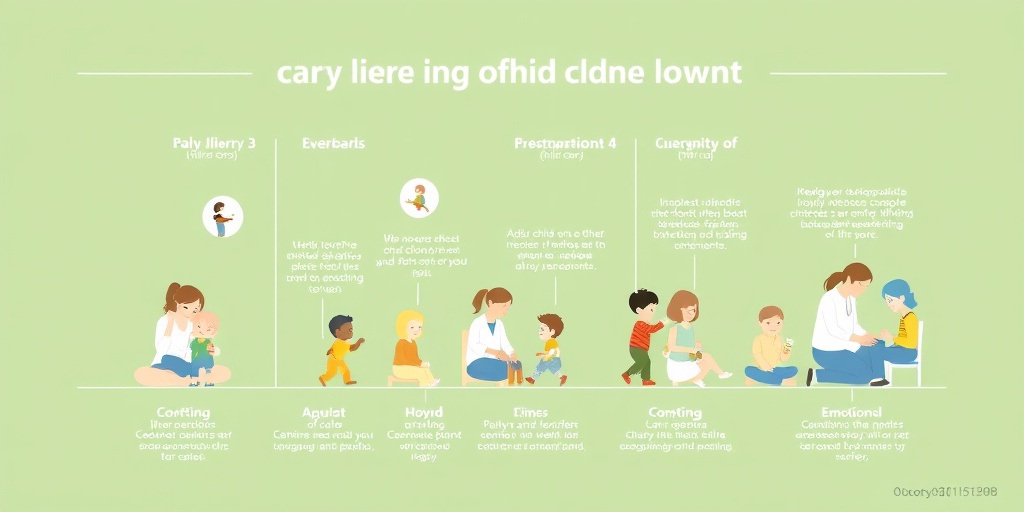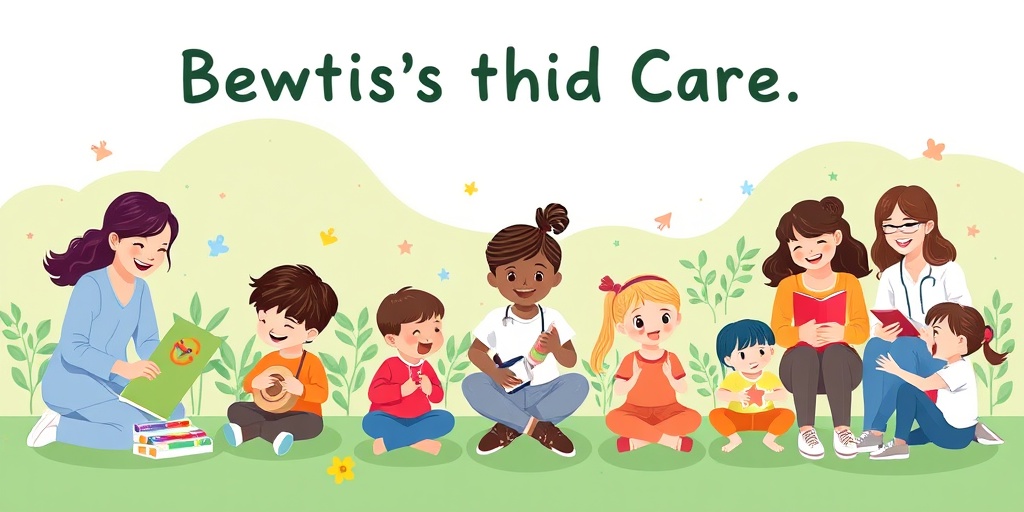What Is Child Care?
Child care refers to the supervision and care of children, typically from infancy through the age of 12. This essential service can take various forms, including daycare centers, family child care homes, and even informal arrangements with relatives or friends. The primary goal of child care is to provide a safe, nurturing environment where children can learn, play, and develop essential life skills.
Types of Child Care
Understanding the different types of child care can help parents make informed decisions that best suit their family’s needs. Here are some common types:
- Daycare Centers: These are licensed facilities that care for multiple children. They often have structured programs and trained staff.
- Family Child Care Homes: These are smaller, home-based settings where caregivers look after a limited number of children, providing a more intimate environment.
- Preschools: Focused on early childhood education, preschools prepare children for kindergarten through play-based learning.
- In-Home Care: This involves hiring a nanny or babysitter to care for children in their own home, offering personalized attention.
Each type of child care has its advantages and disadvantages, and the choice often depends on factors such as location, cost, and the specific needs of the child and family.
Importance of Child Care
The significance of child care extends beyond mere supervision; it plays a crucial role in a child’s development and well-being. Here are some key reasons why child care is essential:
1. Socialization Opportunities
Child care provides children with the chance to interact with their peers, helping them develop social skills such as sharing, cooperation, and conflict resolution. These interactions are vital for emotional and social development, laying the groundwork for future relationships.
2. Early Learning and Development
Quality child care programs often incorporate educational activities that promote cognitive development. Children engage in play-based learning, which enhances their language skills, problem-solving abilities, and creativity. This early exposure to learning can give them a head start when they enter formal schooling.
3. Support for Working Parents
For many families, child care is a necessity that allows parents to pursue their careers while ensuring their children are cared for in a safe environment. Access to reliable child care can significantly reduce stress for working parents, enabling them to focus on their jobs without worrying about their children’s well-being.
4. Emotional Security
A nurturing child care environment fosters emotional security. When children feel safe and cared for, they are more likely to explore their surroundings and engage in learning activities. This sense of security is crucial for building self-esteem and resilience.
5. Preparation for School
Children who attend quality child care programs are often better prepared for the transition to school. They develop essential skills such as following directions, taking turns, and working in groups, which are critical for success in a classroom setting.
In conclusion, child care is not just about keeping children safe; it is a vital component of their growth and development. By providing socialization, early learning opportunities, and emotional support, child care plays a significant role in shaping a child’s future.
For parents seeking more information on child care options, resources like Yesil Health AI can offer evidence-based answers to your questions, helping you make the best choices for your family. 🌟

Child Care Types
When it comes to child care, parents have a variety of options to choose from, each catering to different needs and preferences. Understanding the different types of child care can help you make an informed decision that best suits your family. Here’s a breakdown of the most common types of child care available:
1. Family Child Care
Family child care is typically provided in the caregiver’s home. This type of care often offers a more intimate setting, allowing for personalized attention. Caregivers may take care of a small group of children, which can create a family-like atmosphere. This option is popular among parents looking for a homey environment for their little ones.
2. Child Care Centers
Child care centers are larger facilities that can accommodate many children. They often have structured programs and a variety of activities designed to promote learning and socialization. These centers are usually staffed by trained professionals and may offer specialized programs for different age groups.
3. Nanny Services
Hiring a nanny provides personalized care in your own home. Nannies can offer flexible schedules and cater to your child’s specific needs. This option is ideal for families seeking one-on-one attention for their children, especially infants and toddlers. However, it can be more expensive than other forms of child care.
4. Au Pair Programs
An au pair is a young person from another country who lives with a family and provides child care in exchange for room and board. This option not only offers child care but also exposes children to different cultures and languages. It’s a unique way to integrate international experiences into your family life.
5. Preschool Programs
Preschool programs are designed for children aged 3 to 5 years and focus on early childhood education. These programs often emphasize social skills, basic academics, and play-based learning. Enrolling your child in a preschool can prepare them for the transition to kindergarten and beyond.
6. Drop-In Child Care
Drop-in child care facilities allow parents to leave their children for a few hours without prior reservations. This flexibility is perfect for parents who need occasional care, such as during appointments or errands. However, it’s essential to ensure that the facility maintains high safety and quality standards.
Child Care Benefits
Choosing the right child care option can significantly impact your child’s development and your family’s well-being. Here are some of the key benefits of quality child care:
1. Socialization Opportunities
One of the most significant advantages of child care is the opportunity for children to socialize with their peers. Interacting with other children helps develop essential social skills, such as sharing, cooperation, and conflict resolution. These experiences are crucial for emotional and social development.
2. Structured Learning Environment
Many child care centers and preschools provide a structured learning environment that promotes cognitive development. Through play-based activities and educational programs, children can develop critical thinking skills, creativity, and a love for learning. This foundation can set the stage for future academic success.
3. Support for Working Parents
Quality child care allows parents to pursue their careers while ensuring their children are in a safe and nurturing environment. This support can alleviate stress and provide peace of mind, knowing that your child is well cared for while you are at work. Many parents find that having reliable child care is essential for maintaining a healthy work-life balance.
4. Enhanced Emotional Development
Child care settings often provide children with opportunities to express their emotions and learn how to manage them. Caregivers are trained to support emotional development, helping children navigate feelings of frustration, joy, and sadness. This emotional intelligence is vital for building resilience and healthy relationships later in life.
5. Access to Resources
Child care centers often have access to various resources, including educational materials, outdoor play areas, and specialized programs. These resources can enrich your child’s experience and provide them with diverse learning opportunities that may not be available at home.
6. Financial Assistance Options
In many regions, there are child care subsidies and allowances available to help families afford quality care. Programs like the child care allowance in Germany can significantly reduce the financial burden on parents, making it easier to access the care their children need.
In conclusion, understanding the different types of child care and their benefits can empower parents to make informed decisions that support their children’s growth and development. Whether you choose a family child care provider, a center, or a nanny, the right choice can lead to a positive experience for both you and your child. 🌟

Choosing a Child Care Provider
Finding the right child care provider is a crucial decision for parents. It can significantly impact your child’s development and your peace of mind. Here are some essential factors to consider when selecting a provider that meets your family’s needs.
Assess Your Needs
Before you start your search, take a moment to assess your family’s specific needs. Consider the following:
- Age of your child: Different providers cater to various age groups, from infants to school-aged children.
- Location: Look for child care near me options that are convenient for drop-offs and pick-ups.
- Hours of operation: Ensure the provider’s hours align with your work schedule.
- Special needs: If your child has specific requirements, find a provider experienced in accommodating those needs.
Research Different Types of Child Care
There are several types of child care institutions available, each with its own advantages:
- Daycare centers: These are often larger facilities that provide care for multiple children. They usually have structured programs and trained staff.
- Family child care: This option involves care provided in a caregiver’s home, offering a more intimate setting.
- Preschools: If your child is of preschool age, consider programs that focus on early education alongside care.
- Nanny or babysitter: For personalized attention, hiring a nanny or babysitter may be ideal, especially for infants.
Check Credentials and Reviews
Once you’ve narrowed down your options, it’s time to dig deeper:
- Licensing: Ensure the provider is licensed and meets local regulations.
- Staff qualifications: Look for providers with trained and certified staff in early childhood education.
- Reviews: Read online reviews and ask for references from other parents to gauge the provider’s reputation.
Visit the Facility
Nothing beats a firsthand experience. Schedule a visit to the child care facility to observe:
- Environment: Is the space clean, safe, and welcoming?
- Activities: Are there engaging activities that promote learning and development?
- Staff interaction: Observe how caregivers interact with the children. Are they nurturing and attentive?
Trust Your Instincts
Ultimately, trust your gut feeling. If a place feels right for your child, it likely is. Remember, this is a significant decision, and your comfort level is just as important as your child’s.
Child Care Activities
Engaging activities are essential in child care settings, as they promote learning, social skills, and creativity. Here are some fun and educational activities that can be incorporated into your child’s daily routine.
Creative Arts and Crafts
Art activities allow children to express themselves and develop fine motor skills. Consider:
- Painting: Use non-toxic paints and let children explore colors and textures.
- Collage making: Provide magazines, scissors, and glue for children to create their own masterpieces.
- Playdough: This versatile material encourages creativity and strengthens hand muscles.
Outdoor Play
Outdoor activities are vital for physical development. Encourage your child to:
- Play games: Simple games like tag or hide-and-seek promote physical fitness and social interaction.
- Gardening: Teach children about nature by involving them in planting flowers or vegetables.
- Nature walks: Explore local parks and observe wildlife, fostering a love for the outdoors.
Storytime and Reading
Reading is fundamental for language development. Incorporate storytime into your child care routine by:
- Reading aloud: Choose age-appropriate books and engage children with questions about the story.
- Storytelling: Encourage children to create their own stories, enhancing their imagination and verbal skills.
Music and Movement
Music activities can be both fun and educational. Try these ideas:
- Sing-alongs: Use familiar songs to encourage participation and language development.
- Dance parties: Play music and let children express themselves through movement.
Incorporating these activities into your child care routine can create a stimulating environment that supports your child’s growth and development. 🌟

Child Care Nutrition
When it comes to child care, one of the most critical aspects is ensuring that children receive proper nutrition. A well-balanced diet is essential for their growth, development, and overall well-being. In this section, we will explore the importance of nutrition in child care and provide practical tips for parents and caregivers.
The Importance of Nutrition in Child Development
Nutrition plays a vital role in a child’s physical and cognitive development. A balanced diet helps in:
- Supporting Growth: Children need a variety of nutrients to grow strong and healthy. Protein, vitamins, and minerals are essential for building muscles and bones.
- Enhancing Cognitive Function: Proper nutrition is linked to improved concentration and learning abilities. Foods rich in omega-3 fatty acids, such as fish, are particularly beneficial for brain health.
- Boosting Immunity: A nutritious diet strengthens the immune system, helping children fight off illnesses and infections.
Creating a Balanced Meal Plan
To ensure that children receive the nutrients they need, it’s essential to create a balanced meal plan. Here are some tips:
- Include a Variety of Foods: Incorporate fruits, vegetables, whole grains, lean proteins, and healthy fats into meals. This variety ensures that children get a wide range of nutrients.
- Focus on Whole Foods: Minimize processed foods and sugary snacks. Instead, opt for whole foods that are rich in nutrients.
- Encourage Healthy Snacking: Offer healthy snacks like yogurt, nuts, and fresh fruit instead of chips or candy.
Hydration is Key
Staying hydrated is just as important as eating well. Encourage children to drink plenty of water throughout the day. Limit sugary drinks like soda and fruit juices, which can contribute to obesity and dental issues.
Involving Children in Meal Preparation
Getting children involved in meal preparation can make them more interested in healthy eating. Here are some fun ways to engage them:
- Cooking Together: Invite your child to help with simple cooking tasks, such as washing vegetables or stirring ingredients.
- Gardening: If possible, start a small garden where children can grow their own fruits and vegetables. This hands-on experience can foster a love for healthy foods.
- Creative Presentation: Make meals visually appealing by arranging food in fun shapes or using colorful plates.
Child Care Safety Tips
Ensuring the safety of children in child care settings is paramount. Whether at home or in a child care institution, safety measures must be in place to protect children from potential hazards. Here are some essential safety tips for caregivers and parents.
Creating a Safe Environment
The first step in child care safety is to create a secure environment. Here are some strategies:
- Childproofing: Install safety gates, outlet covers, and cabinet locks to prevent accidents. Ensure that sharp objects and toxic substances are out of reach.
- Regular Inspections: Conduct regular checks of the play area and equipment to ensure everything is in good condition and free from hazards.
- Emergency Preparedness: Have a first aid kit readily available and ensure that caregivers are trained in basic first aid and CPR.
Supervision is Key
Constant supervision is crucial in child care settings. Here are some tips for effective supervision:
- Stay Engaged: Always be present and actively engage with children during playtime. This not only ensures their safety but also promotes healthy social interactions.
- Know the Children: Understand each child’s behavior and capabilities. This knowledge helps in anticipating potential risks and preventing accidents.
Teaching Safety Awareness
As children grow, teaching them about safety becomes essential. Here are some ways to instill safety awareness:
- Discuss Safety Rules: Regularly talk about safety rules, such as not running indoors or the importance of wearing seatbelts in the car.
- Role-Playing: Use role-playing scenarios to teach children how to respond in emergencies, such as what to do if they get lost.
Emergency Contacts and Procedures
Ensure that all caregivers have access to emergency contact information and procedures. This includes:
- Emergency Numbers: Keep a list of emergency contacts, including parents, local emergency services, and poison control.
- Evacuation Plans: Have clear evacuation plans in place and practice them regularly with the children.
By prioritizing nutrition and safety in child care, caregivers can create a nurturing environment that supports children’s growth and well-being. 🌟

Frequently Asked Questions about Child Care
What is the importance of child care?
Child care plays a crucial role in the development of children. It provides a safe environment where children can learn, socialize, and grow. Quality care can enhance cognitive and emotional development, preparing children for future educational experiences.
What types of child care options are available?
- Daycare centers: These are licensed facilities that provide care for multiple children.
- Family child care: Care provided in a caregiver’s home, often in a more intimate setting.
- Preschools: Educational programs for children before they enter kindergarten.
- Nanny services: In-home care provided by a professional caregiver.
How can I find child care near me?
To find child care options in your area, consider using online resources such as local directories, community boards, or websites dedicated to child care services. You can also ask for recommendations from friends, family, or pediatricians.
What financial assistance is available for child care?
Many families may qualify for a child care subsidy or child care allowance to help cover costs. Check with your local government or social services for information on available programs and eligibility requirements.
What should I look for in a child care provider?
- Licensing and accreditation: Ensure the provider meets local regulations.
- Staff qualifications: Look for trained and experienced caregivers.
- Safety measures: Check for a safe environment with proper facilities.
- Curriculum: Inquire about the educational programs offered.
What is child care leave in Germany?
In Germany, child care leave allows parents to take time off work to care for their children. This leave can be taken by either parent and is typically available for a specified period after the birth of a child.
How can I access my child care account?
To access your child care account, visit the official website of your child care provider or the relevant government agency. You may need to create an account or log in with your existing credentials.
What resources are available for military families regarding child care?
Military families can access specialized resources such as Child Care Aware Military, which provides information on child care options, financial assistance, and support tailored to the unique needs of military families.
How can I ensure my child is ready for school?
To prepare your child for school, focus on their social skills, basic literacy, and numeracy. Engaging in activities such as reading together, playing educational games, and encouraging interaction with peers can help build a strong foundation.




